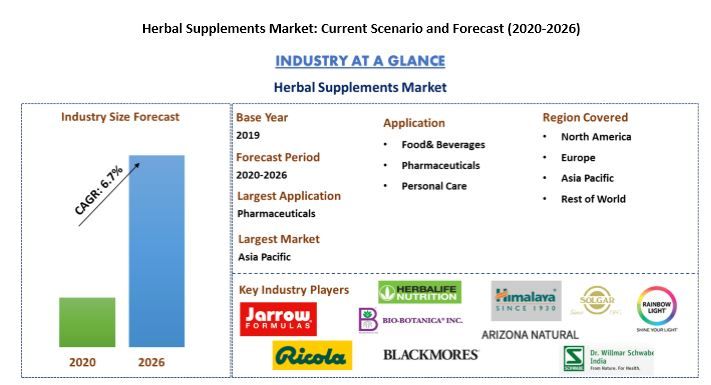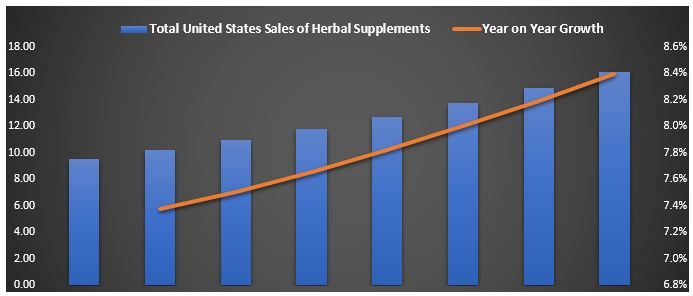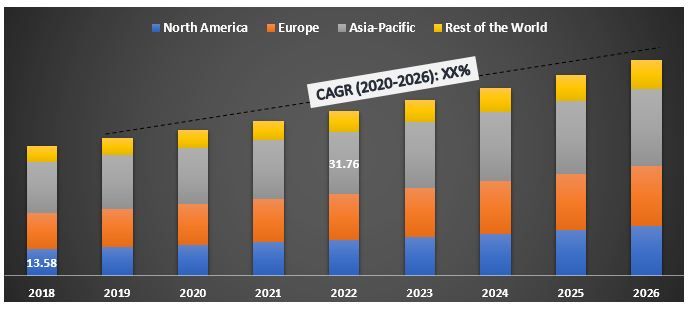- Home
- About Us
- Industry
- Services
- Reading
- Contact Us
Herbal Supplements Market: Current Analysis and Forecast (2020-2026)
Emphasis on Source (Leaves, Roots, Bark, Seeds, Others), Formulation (Tablets, Capsules, Liquid, Powder & Granules, Others), Application (Food & beverages, Pharmaceuticals, Personal Care), End-User (Adult Women, Adult Men, Pediatric, Baby Boomers), Distribution Channel (Herbal Store, Drug store, Supermarket/Hypermarket, Others) and Region/Country
Global herbal supplements market was valued at US$ 70.42 billion in 2019 and is anticipated to reach US$ 110.26 billion by 2026 displaying elevated CAGR of 6.7% over the forecast period (2020-2026). Herbal supplements are the dietary supplements that are extracted from plants or parts of plants for medicinal and therapeutic purposes. Herbal Supplements are used for the prevention and management of various diseases and ailments and are called photomedicine. These supplements work as natural alternatives for hormone replacement therapy, as plants have been used in medicinal purposes for thousands of years. They offer natural ways to improve prostate health, cognitive function and brain health, and connective and joint tissue health. These can be liquids or solids in the form of tablets, capsules, soft gels, gelcaps, or powders. Rising concerns regarding the adverse effects of synthetically derived nutraceuticals are projected to augment the demand for herbal supplements. Increasing spending on health and wellness and rising disposable income levels, especially in the emerging nations, are expected to augment the demand for herbal supplements globally. The preference for buying such herbal products as compared to luxury goods among the consumers is also portraying a dramatic surge. Herbal supplements help maintain cholesterol levels, regulate the digestive system, and reduce stress. Thus, increasing awareness about the health benefits offered by these products is expected to fuel market development.
List of common herbal supplements and their uses
- Aloe Vera: used topically for burns, psoriasis and osteoarthritis. Used in the oral form for digestive issues such as gastritis or constipation.
- Black cohosh: used to treat hot flashes, night sweats, vaginal dryness and menopausal symptoms.
- Chamomile: used to treat sleeplessness, anxiety, upset stomach, gas and diarrhea. It is also used topically for skin conditions. Caution in people with ragweed allergy.
- Echinacea: used to fight cold and flu symptoms.
- Flaxseed: used to lower cholesterol. Good source of fiber and omega-3 fatty acids.
- Ginko: used to treat memory problems and tinnitus (ringing in the ears). It can be used along with the antidepressant selective serotonin reuptake inhibitors (SSRIs) to enhance sex drive and sexual performance in people who have side effects with antidepressant medications. Caution in people taking blood thinners.
- Peppermint oil: used to treat digestion problems such as nausea, indigestion, stomach problems and bowel conditions.
- Soy: used to treat menopausal symptoms, memory problems and high cholesterol levels. Organic, whole soy food is preferable to soy supplements and processed soy foods like soy hot dogs.
- St. John’s Wort: used to treat depression, anxiety and sleep disorders. NOTE: This herb has many other drug and herb interactions. Consult your healthcare provider before starting this supplement
- Tea tree oil: used topically to treat several conditions including, acne, athlete’s foot, nail fungus, wounds, infections, lice, oral yeast infection (thrush), cold sores and dandruff.
United States Retail Sales of Herbal Supplements (US$ Billion, 2019-2026)
“Amongst Source, herbal supplements extracted from Roots dominated the market in 2019, with 42.1% share”
Based on the source, the global herbal supplement market is segmented into leaves, roots, bark, and seeds. The popularity of herbal supplements has witnessed a rapid rise accredited to immense health benefits present in natural products. Consumption of these herbal supplements ensures nutritional enrichment in individuals. Herbal supplements extracted from Roots dominated the market in 2019. However, herbal supplements extracted from Leaves are expected to witness the highest CAGR growth of 7.4% during the forecast period 2020-2026.
“Herbal supplements are majorly consumed in the form of Capsules”
Based on formulations, the global herbal supplement market is bifurcated into tablets, capsules, liquid and powder & granules. Herbal supplements help maintain cholesterol levels, regulate the digestive system, and reduce stress. Thus, increasing awareness about the health benefits offered by these products is expected to fuel market development. Herbal supplements are majorly consumed in the form of Capsules. The segment is expected to generate revenue of US$ 35.71 billion by 2026.
“Pharmaceuticals sector is the largest industrial user of herbal supplements product, followed by F&B and personal care segment”
Based on application, the global herbal supplement market is bifurcated into food & beverages, pharmaceuticals and personal care. Growing inclination towards natural products, increasing health awareness and surging spend on health and wellbeing has catalyzed the growth of the pharmaceutical’s herbal supplement market. The segment generated revenue of US$ 33.74 billion in 2019. In addition, the Personal Care segment is expected to witness the highest CAGR growth of 7.2% during the analyzed period.
“Amongst end-users, Adult women dominated the consumption of herbal supplement”
Based on end-user, the global herbal supplement market is classified into adult women, adult men, pediatric and baby boomers. Growing preference for natural products during pregnancy owing to a surge in awareness regarding the therapeutic properties of herbal supplements is one of the key factors that would boost the demand for herbal supplements among adult women. However, a growing elderly population would help the Baby Boomers end-user segment to witness the highest CAGR growth of 7.4% during the analyzed period.
Herbal Supplements Market Size, Global, 2018-2026 (US$ billion)
“In 2019, herbal supplements were majorly sold through Drug Stores, followed by online channel”
Based on the distribution channel, the global herbal supplement market is bifurcated into herbal stores, drug stores, supermarket/hypermarket and online channels. Preference for e-commerce platforms with respect to ease of availability over conventional distribution channels for buying herbal supplements has risen tremendously due to cost-effectiveness and better convenience leading to the fastest growth over the analyzed period.
“Asia-Pacific dominated the global herbal supplements market in 2019, with 38.9% share”
For a deep-dive analysis of the industry, detailed country-level analysis was conducted for major regions/countries including North America (US, Canada, Rest of North America), Europe (Germany, UK, France, Italy, Spain, Rest of Europe), Asia-Pacific (China, Japan, India, South Korea, Australia, Rest of Asia-Pacific) and Rest of World (Brazil, South Africa, Others). It has been estimated by WHO that 80% of the population of some Asian countries use herbal medicine for some health purposes. Increasing health awareness with respect to diet, growing mental disorders, and surging sedentary lifestyles has tremendously bolstered the Asia Pacific herbal supplements market.
Competitive Landscape-Top 10 Market Players
Jarrow Formulas, Inc., Solgar Inc., Herbalife International of America, Inc., Ricola AG, Bio-Botanica Inc., Blackmores Ltd, Himalaya Drug Company, Rainbow Light Nutritional Systems, Arizona Natural Products, Willmar Schwabe GmbH & Co. KG are some of the prominent players operating in the global herbal supplement industry. Several M&A’s along with partnerships have been undertaken by these players to facilitate customers with hi-tech and innovative products.
Reasons to buy:
- Current and future market size from 2020 to 2025 in terms of value (US$)
- Combined analysis of deep-dive secondary research and input from primary research through Key Opinion Leaders of the industry
- Country-level details of the overall consumption of herbal supplements
- A quick review of overall industry performance at a glance
- In-depth analysis of key industry players
- A detailed analysis of regulatory framework, drivers, restraints, key trends and opportunities prevailing in the industry
- Examination of industry attractiveness with the help of Porter’s Five Forces analysis and start-ups
- The study comprehensively covers the market across different segments and sub-segments of the market
- Region Covered: North America (US, Canada, Rest of North America), Europe (Germany, UK, France, Italy, Spain, Rest of Europe), Asia-Pacific (China, Japan, India, South Korea, Australia, Rest of Asia-Pacific) and Rest of World (Brazil, South Africa, Others)
Customization Options:
UMI understands that you may have your own business need, hence we also provide fully customized solutions to clients. The Global Herbal Supplement market can be customized to the country level or any other market segment.
Table of Content
Analyzing the historical market, estimation of the current market and forecasting the future market for the Herbal Supplement were the three major steps undertaken to create and analyze the consumption trend of the Herbal supplement around the world. Exhaustive secondary research was conducted to collect the historical market numbers and to estimate the current market size. Secondly, to validate these insights, numerous findings and assumptions were taken into consideration. Moreover, exhaustive primary interviews were conducted with industry experts across the value chain of the food & beverage industry. Post assumption and validation of market numbers through primary interviews, the bottom-up approach was employed to forecast the complete market size of the herbal supplement. Thereafter, market breakdown and data triangulation methods were adopted to estimate and analyze the market size of segments and sub-segments the industry pertains to. Detailed methodology is explained below:
Analysis of Historical Market Size
Step 1: In-Depth Study of Secondary Sources:
Detail secondary study was conducted to obtain the historical market size of the Herbal Supplements products through company internal sources such as annual report & financial statements, performance presentations, press releases, etc., and external sources including journals, news & articles, government publications, competitor publications, sector reports, third-party database and other credible publications. For economic data collection, sources such as Trading Economics, Trade Map, World Bank, IMF, FAO among others will be used.
Step 2: Market Segmentation:
After obtaining the historical market size, a detailed secondary analysis was conducted to gather historical market insights and share for different segments & sub-segments for major regions across the world. Major segments included in the report are the source, application, distribution channel, formulation and end-user. Further analysis was also done for major regions/countries to analyze the overall consumption of the Herbal Supplements in that particular country.
Step 3: Factor Analysis:
After acquiring the historical market size of different segments and sub-segments, detailed factor analysis was conducted to estimate the current market size of the Herbal Supplements market. Factor analysis was conducted using dependent and independent variables such as increased demand for healthy foods, increasing awareness for a healthy diet, changing lifestyles and growing incidences of health disorders etc. The demand and supply-side scenario were also thoroughly studied by considering top partnerships, merger and acquisition, business expansion, product launches and analyzing the list of start-ups in the Herbal Supplements market across the globe.
Current Market Size Estimate & Forecast
Current Market Sizing: Based on actionable insights from the above 3 steps, we arrived at the current market size, key players in the Herbal Supplements market and market shares of these players. All the required percentage shares split, and market breakdowns were determined using the above-mentioned secondary approach and were verified through primary interviews.
Estimation & Forecasting: For market estimation and forecast, weight was assigned to different factors including drivers & trends, restraints, and opportunities available for the stakeholders. After analyzing these factors, relevant forecasting techniques i.e. Bottom-up approach was applied to arrive at the market forecast pertaining to 2026 for different segments and sub-segments across major regions/countries globally. The research methodology adopted to estimate the market size encompasses:
- The industry’s market size, in terms of value (US$) and consumption rate of Herbal Supplements across the major regions
- All percentage shares, splits, and breakdowns of market segments and sub-segments
- Key players in the Herbal Supplements market in terms of the product offered as well as market share. Also, the growth strategies adopted by these players to compete in the fast-growing market
Market Size and Share Validation
Primary Research: In-depth interviews were conducted with the Key Opinion Leaders (KOLs) including Top Level Executives (CXO/VPs, Sales Head, Marketing Head, Operational Head, and Regional Head, Country Head, etc.) across major regions/countries. Primary research findings were summarized, and statistical analysis was performed to prove the stated hypothesis. Inputs from primary research would be consolidated with secondary findings, hence turning information into actionable insights.
Split of Primary Participants in Different Regions
Market Engineering
Data triangulation technique was employed to complete the overall market estimation and to arrive at precise statistical numbers of each segment and sub-segment pertaining to the Herbal Supplements market globally. Data was split into several segments & sub-segments post studying various parameters and trends in the areas of source, application, end-user, formulation and distribution channel of the Herbal Supplements market.
Main objective of the Herbal Supplements Market Study
The current & future market trends of the Herbal Supplement market will be pinpointed in the study. Investors can gain strategic insights to base their discretion for investments from the qualitative and quantitative analysis performed in the study. Current and future market trends would determine the overall attractiveness of the market at a regional level, providing a platform for the industrial participant to exploit the untapped market to benefit as a first-mover advantage. Other quantitative goals of the studies include:
- Analyze the current and forecast market size of the Herbal Supplement market in terms of value (US$). Also, analyze the current and forecast market size of different segments and sub-segments of the Herbal Supplement
- Segments in the study include product source, application, end-user, formulation and distribution channel
- Analyze the value chain involved with the presence of various intermediaries, along with analyzing customer and competitor behaviors pertaining to the industry
- Define and analysis of the government regulations for the food & beverage sector around the world
- Detailed analysis of used case study of the Herbal Supplements
- Analyze the current and forecast market size of the herbal products across the globe. Major regions studied in the report include North America (US, Canada, Rest of North America), Europe (Germany, UK, France, Italy, Spain, Rest of Europe), Asia-Pacific (China, Japan, India, South Korea, Australia, Rest of Asia-Pacific) and Rest of World (Brazil, South Africa, Others)
- Define and analyze the competitive landscape of the Herbal Supplements and the growth strategies adopted by the market players to sustain in the fast-growing market
Related Reports
Customers who bought this item also bought














